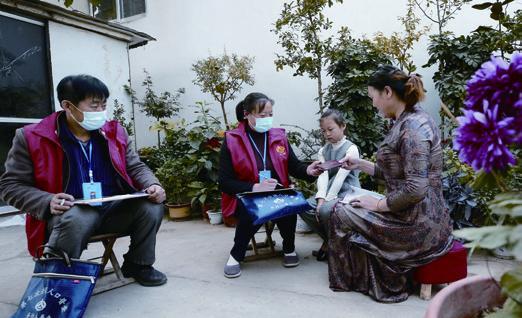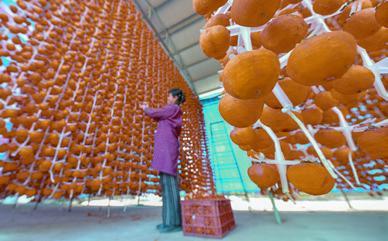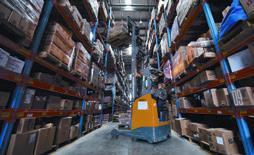NATIONAL HEADCOUNT UNDERWAY

Census takers register a familys information in Qicun Town, Shandong Province in east China, on November 1, the day the seventh national census kicked off. This year, about 7 million workers are going from door to door to document demographic changes in the worlds most populous country.
The census has been held every 10 years in China since 1990. The last one found the population had increased to 1.37 billion.
Fruit Time
A villager dries persimmon in Cixian, a county in Hebei Province in north China, on November 3. Dried persimmon, a popular treat known as shibing in Chinese, has become a distinctive local industry.Religious Freedom
The Islamic Association of Xinjiang Uygur Autonomous Region in northwest China on November 3 released a report on freedom of religious belief in the region.It said some anti-China forces from the United States and other Western countries had recently made fallacious statements that freedom of religious belief was restricted in Xinjiang and mosques were demolished.
They are groundless claims that have severely hurt the feelings of Muslims in Xinjiang and aroused indignation and opposition, the report said.
The right to freedom of religious belief is fully guaranteed in Xinjiang and normal religious activities are carried out in an orderly way. Muslims dietary habits, festivals, wedding and funeral practices, and other customs and rituals are also respected.
Thanks to the strong government support, the condition of mosques has improved. They now have running water, electricity, heating and communications facilities. Roads to mosques have been improved to make access easier, the report added.
Internet Conference
The Seventh World Internet Conference will be held in the river town of Wuzhen in the eastern province of Zhejiang on November 23-24, the Cyberspace Administration of China (CAC) said at a press conference on November 2.The conference will be themed“Digital empowerment to create a better future: jointly build a community of shared future in cyberspace.”
Focusing on artificial intelligence, cloud computing, big data, 5G, the industrial Internet, cyber security and e-business, the conference will have one main forum, five sub-forums, and other activities both online and offline.
The World Internet Development Report 2020 and the China Internet Development Report 2020 will be released during the conference.
CAC Deputy Director Zhao Zeliang said against the backdrop of the novel coronavirus disease pandemic which has profoundly changed the international situation, it is more important than ever to uphold the vision of a community of a shared future in cyberspace.
Global cyberspace should be developed in a more inclusive, balanced and win-win way.
Three Gorges Project
The Three Gorges project, which manages the Yangtze Rivers water flow, has been officially certified as complete and fully functioning, the authorities announced on November 1.The Ministry of Water Resources and the National Development and Reform Commission officially announced full completion of the construction, saying it has met all design requirements, has a good overall performance, and fulfills the key roles of flood control, electricity generation, shipping and waterresource utilization.
The Three Gorges project, which began construction in 1994, is a multi-functional water-control system, consisting of a high dam and 34 turbo-generators with a combined power generating capacity of 22.5 million kilowatts.
The project has played a key role in flood control along the Yangtze River Basin. Since it first began operation until August this year, the dam held back 180 billion cubic meters of water during flood seasons.
It has also reduced flood peaks by about 40 percent, greatly easing flood-control pressure in the middle and lower reaches of the Yangtze.
This has been particularly important along the Jingjiang River, a section of the Yangtze that saw severe flooding in the past.
Great Wall Plan
Gansu Province in northwest China will initiate a conservation plan for the Great Wall, according to the Gansu Provincial Administration of Cultural Heritage.Preparations for a national park management system to protect the Great Wall sections in Gansu are underway, Ma Yuping, director of the administration, said on November 1.
The Gansu section of the Great Wall measures 3,654 km. The Jiayuguan Pass, located 6 km southwest of Jiayuguan City in Gansu, makes it the Great Walls western end. Construction on the Jiayuguan Pass began in 1372 and was completed in 1540. It was listed as a World Cultural Heritage Site by UNESCO in 1987.
The plan involves emergency rescue and reinforcement of the Great Wall itself as well as maintenance and repair of flood control and drainage facilities around the relic sites.
At the planned national park, the Gansu section of the Great Wall will have three exhibition gardens.
They will display the ramming technology in the construction of the Great Wall in northwest China, the history of the ancient Silk Road, and the culture of the Great Wall.
Fully Prepared
A logistics park in Longli, a county in Guizhou Province in southwest China, braces up on November 3 for the Double Eleven Shopping Festival, held on November 11.Reading Festival
Shenzhen, the tech hub in south China, opened its annual monthlong reading festival on November 3. More than 2,200 cultural activities have been lined up, including lectures, book donations and celebrity recommendations for must-read books.The Shenzhen Reading Month has been held each November for the past 20 years, causing UNESCO to name the city a global model for the promotion of reading. This years event is promoting the citys development vitality and cultural charm.
The CITIC Press Group, a Beijing-based publisher and guest of honor at the event, is holding over 50 cultural activities and inviting well-known authors to meet and share their insights with readers in Shenzhen, according to Wang Bin, the company chairman.
Since the festival was launched in 2000, reading has become a part of everyday life in the city, thanks to persistent government promotion and local peoples appetite for knowledge.
More than 160 million people have participated in the festival, with over 8,800 reading and cultural activities held.
Sci-Tech Park
A sci-fi-based science and technology industrial park will be built in a reclaimed steel plant in western Beijing to boost the development of the sci-fi industry.Fu Xiaoming, Deputy General Manager of Beijing Shougang Construction Group Co., announced on November 1 that the company will build a 160,000-square-meter sci-fi city in the Shougang Industrial Park in Beijings Shijingshan District in 10 years.
He made the announcement at the China Science Fiction Conference, which opened in the industrial park that day.
The sci-fi city will have centers for international communication, technological empowerment and consumer experience, as well as a public service platform for graphic image rendering, copyright trading, and digital photography and production.
A sci-fi-themed amusement park is also expected to be set up in the park by the end of 2021.
Shijingshan will establish special funds and roll out policies to support the development of the sci-fi industry.
Founded in 1919, steelmaker Shougang has transformed its past production premises in Shijingshan into a new capital landmark featuring winter sports events, fairs and exhibitions.
It has moved production to the coastal industrial zone of Caofeidian in neighboring Hebei Province.
Autumn Tea
A farmer picks tea leaves in Yingde, a city in Guangdong Province in south China, on November 3. Yingde, with 10,000 hectares of tea plantations, is known as the hometown of black tea.Tibet Subsidy
Tibet Autonomous Region in southwest China has provided 114,000 residents with minimum subsistence allowances in an effort to consolidate the regions accomplishment in poverty alleviation, reported Xinhua News Agency on October 29.The subsidized residents include senior citizens, the differently abled, and children in rural areas, according to Yang Xiaorong, an official with the Department of Civil Affairs of Tibet.
The minimum subsistence allowance in Tibet has been raised to an annual amount of 4,713 yuan($693) per person in 2020, from 2,350 yuan ($354) in 2015, according to Yang.
Konqung, 86, is one of the recipients of the allowance.
“I moved to an old peoples home in the city last year, and now I receive an annual allowance from the government,” he said. “I have nothing to worry about now.”
Tibet has eradicated absolute poverty. By the end of 2019, 628,000 people and 74 countylevel areas had moved out of poverty.
Trade Growth
Trade with the Association of Southeast Asian Nations (ASEAN) accounted for one seventh of Chinas total imports and exports in the first three quarters of the year, reaching $481.8 billion, Chinese Ambassador to ASEAN Deng Xijun said at the Third Jakarta Forum on November 2.“It grew 5.6 percent in the second quarter and 7.7 percent in the third quarter, much faster than that between China and other trading partners,” Deng said.
ASEAN became Chinas largest trading partner in the first half of the year, accounting for 14.7 percent of its total foreign trade volume, amid upgraded free trade area protocol and supply chain cooperation.
This year, China has made $10.7 billion of direct investment in ASEAN countries, up 76.6 percent. “The figures demonstrate the strong resilience and full potential of ChinaASEAN economic relations,” Deng said.
With measures to contain the novel coronavirus disease epidemic in place, China has established“fast lanes” and “green lanes”with Singapore, Laos, Cambodia, Myanmar and Indonesia to facilitate the movement of personnel and resumed direct flights with several ASEAN countries.
Deng said the efforts will stabilize regional production and supply chains, develop new growth modes and thus inject stronger impetus into the economic growth of the countries.
Project in Progress
Construction of a one-stop aircraft maintenance base at the Haikou Meilan International Airport in Haikou, Hainan Province in south China, is in full swing on November 2. After completion, it will serve air companies from home and abroad.Patent Benefits
Award-winning patents have generated massive economic benefits, boosting the high-quality development of intellectual property in China, the National Intellectual Property Administration (NIPA) said on November 2.As of the end of 2018, projects related to the 40 top winners of this years China Patent Award, 30 for invention and 10 for design, had created 660 billion yuan ($98.7 billion) in sales revenue, 62.9 billion yuan ($9.4 billion) in profit, and 136.3 billion yuan ($20.4 billion) in exports, Lei Xiaoyun, a NIPA official, said at a press conference in Beijing.
The China Patent Award, the countrys top award in the field, has been co-organized by NIPA and the World Intellectual Property Organization since 1989.
According to Lei, candidates for this years awards reached a recordbreaking 2,479.
“Of the 766 award-winning invention patents, 62 percent are in strategic emerging industries, and 83 percent in patent-intensive sectors,”Lei said, adding that most awardwinning patent projects involve key industries and core technologies.
Stronger Web Firms
Chinas Internet and related sectors registered double-digit growth in business revenue in the first three quarters of the year, official data showed.Major Internet companies raked in 895.6 billion yuan ($134.7 billion) in the period, up 13.7 percent year on year, according to the Ministry of Industry and Information Technology (MIIT).
The operating profit of the industry grew 13.6 percent year on year to 86.74 billion yuan($13 billion).
Its spending on research and development totaled 49.74 billion yuan ($7.48 billion), up 11.2 percent over the same period last year.
MIIT statistics cover enterprises with annual revenue from Internet services of above 5 million yuan($752,000) in the previous year.
Smart Airports
During the 13th Five-Year Plan (2016-20) period, industry-wide efforts have been made to develop smart airports, highlighting data sharing, effective coordination and intelligent operations, Dong Zhiyi, deputy head of the Civil Aviation Administration of China (CAAC), said at a conference in Xiamen, Fujian Province in southeast China. The conference was held on October 29-30.
China has set up big databases to sustain industry operations and put into use a range of new technologies in fields such as airport security management, flight management and operations control at airports, he said.
Salt Harvest
Workers collect salt at a salt field in Qingdao, Shandong Province in east China, on November 4.NEV Plan
A development plan for Chinas new-energy vehicle (NEV) industry in 2021-35 said the country will become an automotive powerhouse.The plan, released by the State Council on November 2, lists five strategic tasks—improving technology innovation capacity, building new-type industry ecosystems, advancing industrial integration and development, upgrading the infrastructure system, and expanding opening up and cooperation.
The targets include bringing the average power consumption of electric cars down to 12 kWh/100 km and raising the proportion of NEVs in new vehicle sales to 20 percent by 2025.
By 2035, electric automobiles are likely to become the mainstream in the new vehicle market, while all vehicles used in public transportation will be electrified, according to the plan.
Boasting the worlds most sizable inventory of NEVs, China accounts for 55 percent of global NEV sales.
LNG Deal
The Shanghai Petroleum and Natural Gas Exchange (SHPGX) executed its first international liquefied natural gas (LNG) tender transaction on November 2.According to the tender result, Chinese oil and gas giant CNOOC will purchase 65,000 tons of LNG to be delivered in March 2021 from Aramco Trading Singapore.
On October 30, SHPGXs online international LNG trading system launched purchase and sales tender services for international traders.
Sinopec and CNOOC announced purchase tenders through the system on the same day, seeking to purchase overseas LNG to be delivered in the subsequent months.
A number of foreign gas suppliers, including Total, Mitsui & Co., Glencore, RWE and Aramco Trading Singapore, were invited to participate in the tenders.
SHPGX said it is mulling the establishment of a group purchasing service for small and mediumsized LNG buyers in accordance with market demand.
Poverty-Relief Initiative
Shoppers select commodities at the China Western Consumption Poverty Alleviation Center in Chongqing, southwest China, on October 31. The 15,000-square-meter building has more than 40 pavilions, presenting products from impoverished areas.Tibets Economy
The GDP of Tibet Autonomous Region in southwest China totaled 130.8 billion yuan ($19.5 billion) in the first three quarters of the year, up 6.3 percent year on year, local authorities said on October 29.Seven emerging sectors empowered the regions economy—plateau biology, tourism and culture, green industries, clean energy, modern services, border trade logistics, and the hi-tech and digital industry, according to the regional bureau of statistics and the Tibet survey office under the National Bureau of Statistics.
They achieved a value-added output of 28.9 billion yuan ($4.3 billion) from January to September, with the hi-tech and digital industry surging 37 percent year on year and the plateau bio-industry up 31.6 percent.
The pharmaceuticals is another pillar industry in the region. Its value-added output soared 36.6 percent year on year in the first three quarters, compared with a 7.1-percent growth of all major industries.

